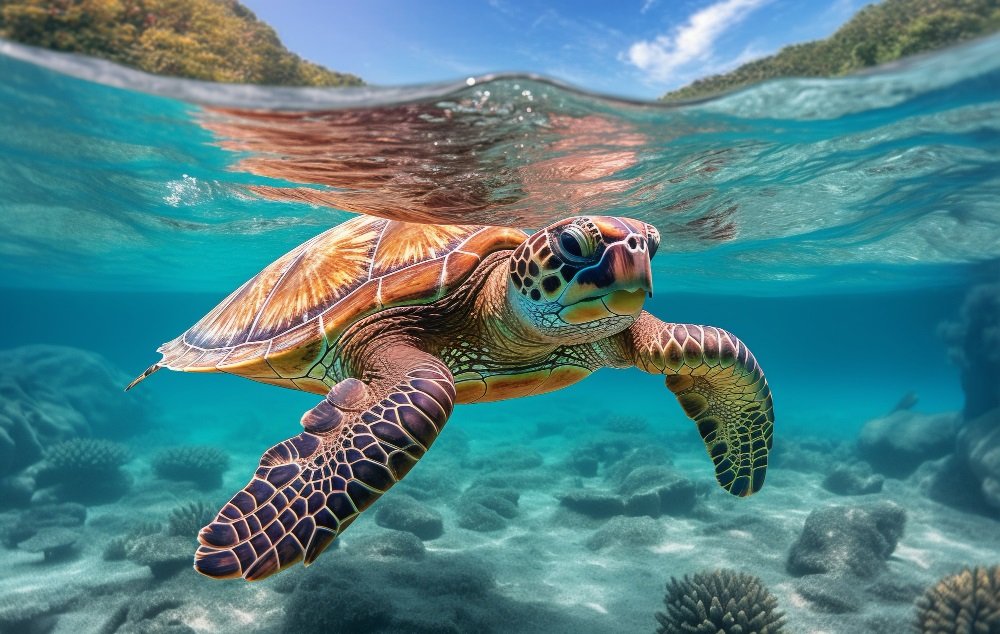Sea turtles have been an integral part of our planet’s ecosystem for over 100 million years, playing a vital role in maintaining the delicate balance of our oceans. These incredible creatures are not only a fascinating sight to behold, but they also contribute significantly to the health of our marine environment. However, their populations are facing unprecedented threats, and it is essential that we take immediate action to protect them.
Why Protecting Sea Turtles Matters
Sea turtles are a keystone species, which means that they have a disproportionate impact on their environment relative to their abundance. They help to maintain the health of seagrass beds, coral reefs, and mangrove forests, which in turn support a vast array of marine life. The loss of sea turtles would have far-reaching consequences for the entire ecosystem, leading to a decline in biodiversity and the collapse of delicate food chains.
The Importance of Sea Turtles in the Marine Ecosystem
Sea turtles are ecosystem engineers, modifying their environment in ways that benefit other species. For example, they help to disperse seeds, facilitating the growth of new vegetation in coastal areas. They also prey on jellyfish, keeping their populations in check and preventing them from overwhelming other marine animals. Additionally, sea turtles act as indicators of ocean health, providing valuable insights into the impacts of pollution, climate change, and other human activities.
By protecting sea turtles, we are not only ensuring the survival of these incredible creatures, but also safeguarding the health of our oceans and the many species that depend on them. In this article, we will explore the importance of protecting sea turtles, the threats they face, and the actions we can take to make a positive impact on their populations.
Why Is It Important to Protect Sea Turtles?
Sea turtles have been an integral part of our planet’s ecosystem for over 100 million years, playing a vital role in maintaining the health of our oceans. However, their populations are facing numerous threats, and it is essential to take immediate action to protect these incredible creatures. In this article, we will explore the importance of protecting sea turtles and the consequences of not doing so.
The Ecological Importance of Sea Turtles
Sea turtles are a keystone species, meaning they have a disproportionate impact on their environment relative to their abundance. They play a crucial role in maintaining the balance of their ecosystems, and their loss could have significant cascading effects on the entire food chain.
Some of the key ecological roles that sea turtles fulfill include:
- Seed dispersal and germination: Sea turtles help to disperse seeds from the fruits they consume, contributing to the growth of new plants and maintaining the diversity of coastal ecosystems.
- Beach maintenance: Sea turtles help to maintain the shape and structure of beaches by digging nests and creating pathways, which can help to prevent erosion and promote the growth of vegetation.
- Marine ecosystem engineering: Sea turtles help to maintain the structure of marine ecosystems by creating pathways and burrows that provide habitat for other species.
- Nutrient cycling: Sea turtles help to cycle nutrients through ecosystems by consuming seaweed and seagrass, which helps to maintain the health of these habitats.
The Economic Importance of Sea Turtles
Sea turtles also have significant economic importance, particularly in coastal communities that rely on tourism and fishing industries. (See Also: What Country Do Sea Turtles Live In)
Some of the key economic benefits of sea turtles include:
- Tourism: Sea turtles are a major draw for tourists, who come to observe these incredible creatures in their natural habitat. This can generate significant revenue for local communities.
- Fishing industries: Sea turtles help to maintain the health of fisheries by controlling the populations of species that might otherwise become pests.
- Coastal protection: Sea turtles help to maintain the health of coastal ecosystems, which can reduce the risk of natural disasters such as hurricanes and tsunamis.
Threats to Sea Turtle Populations
Despite their importance, sea turtle populations are facing numerous threats that could lead to their extinction if left unchecked.
Some of the key threats to sea turtle populations include:
- Habitat destruction: The destruction of coastal habitats such as coral reefs, mangroves, and seagrass beds is a major threat to sea turtle populations.
- Entanglement in fishing gear: Sea turtles can become entangled in fishing gear, which can lead to injury or drowning.
- Pollution: Pollution from plastics, oil spills, and other human activities can harm sea turtles and their habitats.
- Climate change: Climate change is altering the distribution and abundance of sea turtle prey, making it harder for them to survive.
- Poaching: Sea turtles are hunted for their meat, eggs, and shells, which can lead to significant population declines.
Consequences of Not Protecting Sea Turtles
If we fail to protect sea turtle populations, the consequences could be severe and far-reaching.
Some of the potential consequences of not protecting sea turtles include:
- Loss of biodiversity: The loss of sea turtles could lead to a decline in biodiversity, as they play a crucial role in maintaining the balance of their ecosystems.
- Disruption of ecosystem services: The loss of sea turtles could disrupt the ecosystem services they provide, leading to a decline in the health of coastal ecosystems.
- Economic impacts: The loss of sea turtles could have significant economic impacts on coastal communities that rely on tourism and fishing industries.
- Cascading effects: The loss of sea turtles could have cascading effects on entire ecosystems, leading to the decline or extinction of other species that rely on them.
What Can Be Done to Protect Sea Turtles?
Fortunately, there are many ways to protect sea turtle populations and mitigate the threats they face.
Some of the key actions that can be taken to protect sea turtles include:
- Conservation efforts: Establishing protected areas and conservation programs can help to protect sea turtle habitats and reduce the impact of human activities.
- Research and monitoring: Researching and monitoring sea turtle populations can help us to better understand their behavior, habitat needs, and population trends.
- Education and outreach: Educating the public about the importance of sea turtles and the threats they face can help to build support for conservation efforts.
- Policy and legislation: Strengthening policy and legislation can help to protect sea turtles by prohibiting activities that harm them, such as hunting and habitat destruction.
- Community engagement: Engaging with local communities can help to build support for sea turtle conservation and promote the adoption of sustainable practices.
Success Stories in Sea Turtle Conservation
There are many success stories in sea turtle conservation, which demonstrate the effectiveness of conservation efforts. (See Also: What Do Turtles Rat)
Some examples of successful sea turtle conservation programs include:
- Sea turtle conservation in Costa Rica: Costa Rica has made significant progress in protecting its sea turtle populations through conservation efforts, research, and education.
- The Sea Turtle Conservancy: The Sea Turtle Conservancy is a non-profit organization that works to protect sea turtles and their habitats through research, conservation, and education.
- The World Wildlife Fund’s sea turtle program: The World Wildlife Fund’s sea turtle program works to protect sea turtles and their habitats through conservation efforts, research, and policy work.
Conclusion
In conclusion, protecting sea turtles is essential for maintaining the health of our oceans and the ecosystems they support. Sea turtles play a vital role in maintaining the balance of their ecosystems, and their loss could have significant cascading effects on entire ecosystems.
It is essential that we take immediate action to protect sea turtle populations, including conservation efforts, research, education, policy, and community engagement. By working together, we can ensure the long-term survival of these incredible creatures and the ecosystems they inhabit.
Recap of key points:
- Sea turtles are a keystone species that play a crucial role in maintaining the balance of their ecosystems.
- They have significant ecological and economic importance, including seed dispersal, beach maintenance, marine ecosystem engineering, and nutrient cycling.
- Sea turtle populations are facing numerous threats, including habitat destruction, entanglement in fishing gear, pollution, climate change, and poaching.
- The consequences of not protecting sea turtles could be severe, including the loss of biodiversity, disruption of ecosystem services, economic impacts, and cascading effects on entire ecosystems.
- Conservation efforts, research, education, policy, and community engagement are essential for protecting sea turtle populations and mitigating the threats they face.
We hope that this article has highlighted the importance of protecting sea turtles and the need for immediate action to ensure their long-term survival.
By working together, we can make a difference and protect these incredible creatures for future generations.
Frequently Asked Questions: Why Is It Important To Protect Sea Turtles
What is the role of sea turtles in maintaining the health of our oceans?
Sea turtles play a crucial role in maintaining the health of our oceans. They help to maintain the balance of marine ecosystems by controlling seaweed growth, facilitating the growth of coral reefs, and serving as a food source for other marine animals. Additionally, sea turtles help to maintain the health of seagrass beds and mangrove forests, which provide important habitats for many other marine species. (See Also: Why Is One Of My Turtles Eyes Closed)
How do sea turtles contribute to the economy and human well-being?
Sea turtles contribute significantly to the economy and human well-being through ecotourism, which generates income and creates jobs for local communities. Sea turtles also provide a source of income for fishermen who catch them sustainably, and their eggs are a valuable source of protein for many people around the world. Furthermore, sea turtles help to maintain the health of coastal ecosystems, which provide important ecosystem services such as shoreline protection and water filtration.
What are the consequences of sea turtle decline on the environment?
The decline of sea turtle populations can have significant consequences for the environment. Without sea turtles, seaweed can overgrow coral reefs, causing them to die and leading to the loss of biodiversity. The loss of sea turtles can also lead to the decline of seagrass beds and mangrove forests, which provide important habitats for many other marine species. Additionally, the decline of sea turtles can disrupt the food chain and lead to the decline of other marine species that rely on them as a food source.
How do human activities impact sea turtle populations?
Human activities such as coastal development, fishing, and pollution can have significant impacts on sea turtle populations. Coastal development can lead to the destruction of sea turtle habitats, such as nesting beaches and coral reefs. Fishing gear can entangle and kill sea turtles, while pollution can harm them and their habitats. Additionally, climate change can cause sea levels to rise, which can lead to the loss of sea turtle habitats and make it more difficult for them to adapt to changing environmental conditions.
What can individuals do to help protect sea turtles?
Individuals can help protect sea turtles by making conscious choices in their daily lives. For example, they can reduce their use of plastics, which can end up in the ocean and harm sea turtles. They can also support organizations that work to protect sea turtles and their habitats, and make sustainable seafood choices. Additionally, individuals can spread awareness about the importance of sea turtle conservation and encourage others to take action to protect these incredible creatures.


